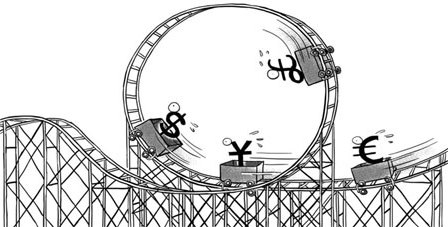
|
OPINION> Commentary
 |
|
Exchange rates on another roller coaster ride?
By Kenneth Rogoff (China Daily)
Updated: 2008-12-24 07:41
The year of 2008 has been an exceptionally tumultuous year for exchange rates. The US dollar soared, the Japanese yen went into orbit, the euro fell to earth, and the British pound crashed, leaving a giant crater. Emerging-market currencies were hammered, as were "commodity currencies" such as the Canadian, Australian, and New Zealand dollars, and the South African rand. Indeed, the currency of any country that is significantly dependent on commodity exports has suffered. So, what will the New Year bring for exchange rates? While the only safe bet is continuing high volatility, we are at an unusual juncture where the short- and long-term trends appear to be very different. In the short run, the yen and the dollar continue to benefit from a flight to safety, as panicked investors seek a place to hide. The yen and dollar are also being bolstered as central banks elsewhere continue to cut interest rates towards zero, territory that the yen and dollar policy rates already occupy. Thus, even though the United States and Japan will not be raising interest rates anytime soon, lower foreign rates still make the dollar and yen relatively more attractive. Commodity prices will continue to be soft, pulling down commodity currencies, and bolstering the yen especially, since resource-poor Japan is so reliant on commodity imports. Normally, short-run and long-run exchange-rate trends point in the same direction. Indeed, a huge body of research shows that for most major currencies, the best forecast of next week's exchange rate, next month's exchange rate, or even next year's exchange rate is simply today's exchange rate. But times are hardly normal. The continuing financial crisis is putting steady upward pressure on the dollar thanks to its safe haven status. Commodity prices are plumbing new depths. Yet the financial crisis will eventually end, as will the global recession. Neither will end soon, mind you, perhaps not for another seven or eight months, if not longer. But, when more normal growth does resume, the recent trends underpinning dollar and yen appreciation will disappear. Perhaps international investors will be grateful to the US for its aggressive monetary and fiscal stimulus, which will accelerate sharply when President-elect Barack Obama takes office on Jan 20. But investors will still worry about what happens when the bills come due. Many emerging markets will also want to engage in countercyclical macroeconomic policy, but they are hemmed in by concerns of fiscal sustainability and fear of rampant inflation. European fiscal policy is constrained by the Maastricht Treaty, while European monetary policy is rather single-mindedly devoted to price stability. True, China, with its vast foreign exchange reserves, has the wherewithal to spend as much on countercyclical macroeconomic policy as anyone. But China's decesion-makers know that their banking system is vulnerable as the country continues to pursue gradual financial liberalization, and that foreign currency reserves may be needed for recapitalization. Thus perhaps no region will be as expansionary as the US. For the moment, global investors cannot get enough of US treasury bills, as collapsing interest rates for short-term US securities demonstrates. But a lot of this demand is driven by short-term, crisis-fueled fear. As markets normalize, surely investors will look around and realize that the US has vastly increased its debt in fighting the downturn, possibly by several trillion dollars. At the same time, today's falling prices (or "deflation") will eventually morph into inflation as aggressive monetary easing takes its toll on price stability. Admittedly, some of the major currency's movements during the past year can be regarded as normalizing. On a purchasing power basis (a crude measure of what different currencies can buy in terms of real goods), the euro was absurdly overvalued at $1.60, just as the yen was absurdly undervalued at over 120 yen to the dollar. Commodity currencies had to come off their meteoric highs. Thus, the past year's currency alignments have, to some extent, simply brought relative domestic price levels and exchange rates into better balance. But by now, emerging-market countries' exchange rates, and even more so commodity currencies, have probably overshot on the downside. Over the long run, globalization and economic convergence will resume, and emerging market and commodity currencies will have to strengthen. At the same time, the prospect of higher US inflation and massively higher US public debt levels must eventually weigh on the dollar, as does the still worrisome US trade deficit. As for the yen, it, too, will suffer from the continuing rise in Japan's public debt levels, which are already among the highest in the world. Continuing weakness in the Japanese economy will eventually hit the yen. If today's constellation of exchange rates represents some excessive dollar and yen appreciation, especially against emerging-market currencies, when it will unwind? That depends on when you think the financial crisis will abate, and the timing of that is as hard to predict as exchange rates. But come it will. Then watch for the dollar and yen to boomerang. The author is professor of economics and public policy at Harvard University, and was formerly chief economist at the IMF Project Syndicate
 (China Daily 12/24/2008 page9) |